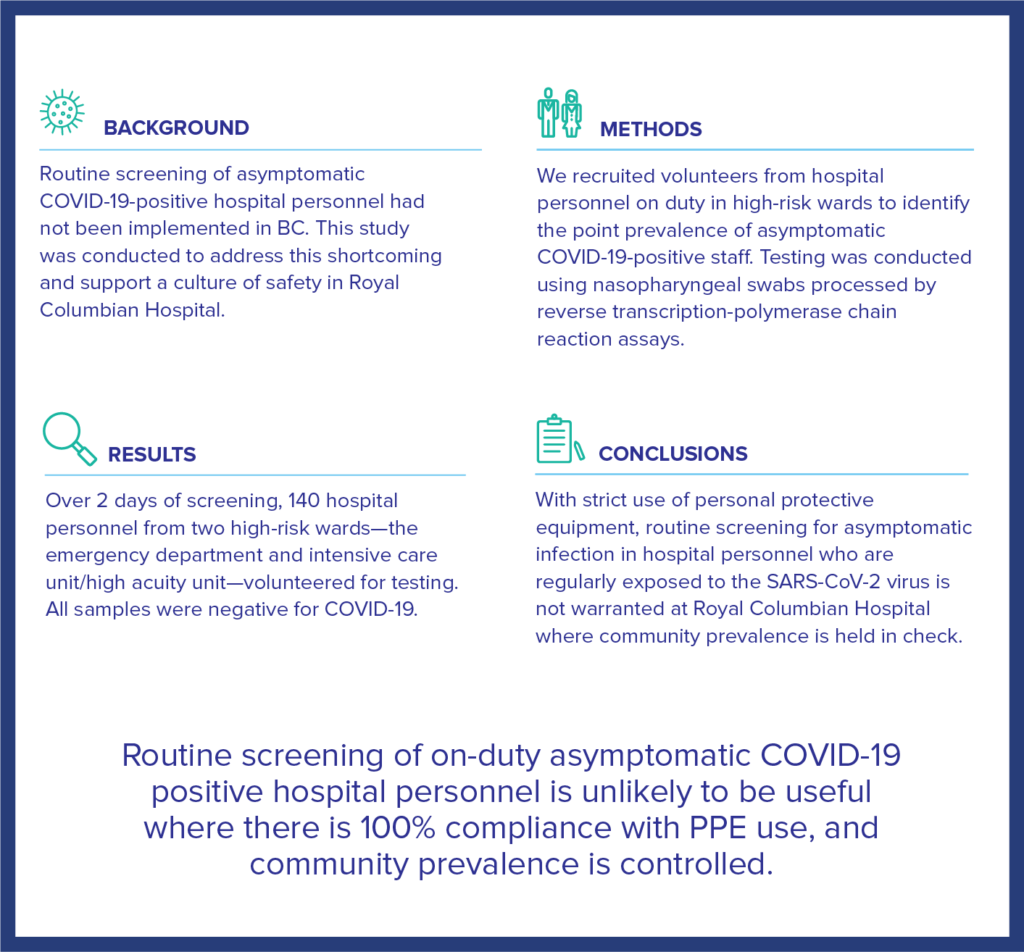In a recently published study, EM Network members Brian Deady and John Taylor investigated whether asymptomatic personnel on high-risk wards in a large, urban hospital should be routinely screened for COVID-19.
How the Study Came About
In March 2020, we read about the devastation of the first wave of SARS-CoV-2 infection in northern Italy. The healthcare system was overwhelmed, patients were dying in the thousands, and COVID struck down multiple Italian physicians.
Drs. Andrea Crisanti and Antonio Cassone in Vo, Italy, became media darlings for their shocking discovery there. Briefly, this town recorded the country’s first COVID-19 death. Shortly after that, every one of its 3,300 citizens was tested, and 50-75% of the positive cases were asymptomatic. All positive cases were isolated, and the infection rate quickly dropped to almost zero. This result was startling given the rate of infection and mortality in surrounding regions.
Also, recall that we were only testing symptomatic healthcare workers and returning travellers at that time in BC. There seemed to be no plan to look for asymptomatic infections and certainly, there was no proposal to screen healthcare workers. We saw an opportunity.
“… there was no proposal to screen healthcare workers. We saw an opportunity.”
We didn’t count on the difficulty in utilizing the lab-based RT-PCR test, which, despite being the operational gold standard for SARS-CoV-2 detection, was in short supply for research initiatives, particularly in the Fraser Health Authority. We missed the first wave because of the province-wide restriction of PCR testing for researchers. The study was finally carried out before the vaccines became available in November 2020. Even at this later date, we were shut out of the inpatient COVID ward because of reagent shortage and could only test the ED and the ICU/HAU. We found 0/140 infections in volunteer hospital personnel.
Key Takeaways
- Strict adherence to PPE is protective and prevents patient-to-healthcare worker transmission in the workplace.
- The case rate for the North Fraser region, an area within Fraser Health that corresponds to the catchment of Royal Columbian Hospital, was significantly lower than that quoted for FHA generally.
- Infection among healthcare workers likely reflects community transmission rather than in-hospital exposure.
- Truly asymptomatic COVID-19-positive healthcare workers likely form a very small, perhaps even negligible, subset of the workforce.
- With strict use of personal protective equipment, routine screening for asymptomatic infection in hospital personnel who are regularly exposed to the SARS-CoV-2 virus is not warranted at Royal Columbian Hospital, where community prevalence is held in check.
- Our study was a small, single-site investigation that may not be generalizable to other hospitals.
Implications for Urban and Rural BC
The message is the same for urban and rural areas of BC. Strict usage of PPE while on duty is protective. The community is where you are more likely to get infected.
Currently, there are multiple media reports of vaccine break-through infections, that is, fully vaccinated individuals becoming infected with COVID-19, particularly in the face of the Delta variant. Fortunately, its effects are significantly reduced for most vaccinated people, and the overwhelming majority of hospitalizations and deaths are among the unvaccinated.
In America, the CDC recommends that vaccinated people should return to using masks indoors. Just today, BC has declared an outbreak in Central Okanagan and is reimposing a local mask mandate.
Comments?
The SARS-CoV-2 virus continues to simultaneously frighten, frustrate and fascinate. It seems the final chapter has yet to be written. Thank you for reading the blog and I look forward to any comments you may have about our research article.
View the full study, Point prevalence of asymptomatic COVID–19–positive hospital personnel on high–risk wards in a large urban hospital in British Columbia, in the BC Medical Journal.
COMMENTS (0)
Add public comment…



POST COMMENT
We welcome your contribution! If you are a member, log in here. If not, you can still submit a comment but we just need some information.